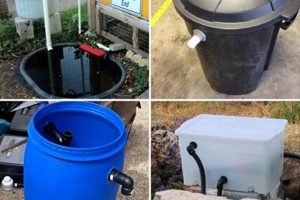The phrase represents methods and strategies individuals employ to manage mosquito populations and mitigate the risks associated with mosquito bites, all without professional assistance. These efforts often involve eliminating breeding grounds, deploying traps, and applying repellents. For instance, removing standing water from containers around a property or using citronella candles exemplifies such self-reliant mosquito management practices.
Autonomous methods of mosquito reduction can offer several advantages. They provide a cost-effective alternative to professional pest control services and empower individuals to take direct action to protect themselves and their families. Historically, communities have relied on personal initiative to address mosquito problems, particularly in areas where access to professional services is limited or unaffordable. The effectiveness of individual measures, when combined and consistently applied across a neighborhood, can contribute to a significant reduction in mosquito populations.
Subsequent sections will explore a range of practical, safe, and effective strategies for achieving control. These will include detailed guidance on eliminating breeding sites, constructing simple traps, selecting appropriate repellents, and implementing preventative landscaping techniques. Emphasis will be placed on methods that minimize environmental impact and prioritize the health and safety of residents.
DIY Mosquito Control Tips
Effective reduction of mosquito populations around residential areas requires consistent and multi-faceted strategies. Employing the following techniques can significantly minimize the risk of mosquito bites and the diseases they may carry.
Tip 1: Eliminate Standing Water: Mosquitoes require water to breed. Regularly inspect and empty containers such as flower pots, bird baths, gutters, and discarded tires. Ensure proper drainage in yards to prevent water accumulation after rainfall.
Tip 2: Maintain Swimming Pools and Water Features: If a swimming pool is not actively in use, it should be properly covered and treated to prevent mosquito breeding. Water features such as ponds and fountains should be equipped with pumps or aerators to keep the water moving, thus deterring mosquito oviposition.
Tip 3: Use Mosquito Dunks or Briquettes: These products contain Bacillus thuringiensis israelensis (Bti), a bacterium toxic to mosquito larvae but harmless to humans, pets, and other wildlife. Place dunks or briquettes in standing water sources that cannot be eliminated, such as rain barrels or ornamental ponds.
Tip 4: Apply Insect Repellents: When outdoors, use insect repellents containing DEET, picaridin, oil of lemon eucalyptus (OLE), or IR3535. Apply repellents according to the product label, paying attention to age restrictions and precautions.
Tip 5: Install or Repair Window and Door Screens: Ensure all windows and doors have intact screens to prevent mosquitoes from entering the home. Repair any holes or tears in existing screens promptly.
Tip 6: Use Mosquito Traps: Various mosquito traps are available for purchase or can be constructed. These traps attract and capture mosquitoes, reducing the overall population. Consider traps that utilize carbon dioxide or attractant scents.
Tip 7: Employ Fans: Mosquitoes are weak fliers. Using fans outdoors can disrupt their flight patterns and make it more difficult for them to reach potential hosts.
Consistent application of these methods results in a marked decrease in mosquito activity around the home. Vigilance in removing breeding sites is paramount, as is the responsible use of repellents and other control measures.
The succeeding sections will delve into the long-term strategies for mosquito management, including landscaping techniques and community-based initiatives.
1. Source Reduction
Source reduction is a fundamental component of effective mosquito management. It addresses the root cause of mosquito proliferation by eliminating or modifying the habitats where mosquitoes breed. Without source reduction, other control methods offer only temporary relief, necessitating repeated application and increased reliance on chemical interventions. Standing water, even in small quantities, serves as a breeding ground, allowing mosquitoes to complete their life cycle from egg to adult.
The practice involves identifying and removing containers or areas where water accumulates. Examples include emptying flower pots, upturned buckets, and discarded tires. Cleaning clogged gutters and leveling uneven ground to prevent water pooling also contribute to source reduction. This proactive approach significantly reduces the number of mosquito larvae reaching adulthood, thereby decreasing the overall mosquito population in the surrounding area. Consistent effort in source reduction has a long-term impact on mosquito densities. For example, a community that consistently removes standing water from properties can expect a noticeable reduction in mosquito-borne disease risk compared to a community that relies solely on spraying insecticides.
The success of other management methods depends on effective application. It also represents a sustainable and environmentally responsible approach to mosquito control. Neglecting source reduction renders other control measures less effective and perpetuates the need for ongoing interventions. By prioritizing source reduction, a more effective and enduring solution is achieved.
2. Larvicide Application
Larvicide application represents a proactive strategy within . It targets mosquitoes during their aquatic larval stage, preventing them from maturing into biting adults. This intervention directly reduces the mosquito population by disrupting their life cycle before they can transmit diseases. Larvicides, such as Bacillus thuringiensis israelensis (Bti) dunks or briquettes, are often employed in standing water sources that cannot be easily eliminated, such as rain barrels, ponds, or drainage ditches. Bti is a naturally occurring bacterium that is toxic to mosquito larvae but harmless to humans, pets, and other wildlife, rendering it a suitable option for residential use. The effectiveness of larvicide application is evident in areas where targeted treatments of mosquito breeding sites have led to significant reductions in mosquito populations and associated disease transmission rates.
The appropriate selection and application of larvicides are crucial for success. Homeowners must adhere to label instructions, ensuring the correct dosage and application method are used. Overuse or improper application can lead to unintended environmental consequences, while underuse can render the treatment ineffective. Larvicides should be applied regularly, particularly during peak mosquito breeding seasons, to maintain control. In regions with high mosquito activity, community-wide larvicide program
s, involving residents treating their own properties, can be implemented for a broader impact. This collaborative effort amplifies the effectiveness of individual actions, contributing to a more significant reduction in mosquito populations across the entire area.
The application of larvicides constitutes an essential element for management. By focusing on the larval stage, it prevents the emergence of adult mosquitoes, limiting their ability to bite and transmit diseases. While source reduction remains the primary line of defense, larvicide application provides a complementary approach for managing standing water sources that cannot be readily eliminated, ensuring more comprehensive protection. This strategy is environmentally responsible when implemented correctly. This contributes to the overall efficacy of controlling mosquito numbers.
3. Repellent Usage
Repellent usage is a key component of individual mosquito management. It provides a personal barrier against mosquito bites, reducing the risk of disease transmission. The selection and application of appropriate repellents are essential for achieving effective protection within the framework of individual mitigation efforts.
- Selecting Appropriate Repellents
The efficacy of a repellent depends on its active ingredient and concentration. DEET, picaridin, oil of lemon eucalyptus (OLE), and IR3535 are EPA-registered options. Selecting a product with the appropriate concentration for the intended exposure duration is critical. Higher concentrations typically offer longer protection, but potential skin sensitivity must be considered. Choosing the right repellent is therefore a critical step.
- Proper Application Techniques
Repellents must be applied correctly to exposed skin to maximize their effectiveness. Application should be even and thorough, following label instructions. Repellents are generally not recommended for application under clothing, and aerosol formulations should be applied in well-ventilated areas. Proper application enhances protection and minimizes potential adverse effects.
- Considerations for Children and Infants
The use of repellents on children and infants requires special caution. The American Academy of Pediatrics recommends using repellents with no more than 30% DEET on children over two months of age and avoiding DEET products altogether on infants younger than two months. OLE repellents are not recommended for children under three years old. Alternative protective measures, such as mosquito netting, should be prioritized for young children.
- Complementary Strategies
Repellent usage is most effective when combined with other mosquito control measures. Eliminating breeding sites around the home, wearing protective clothing, and using mosquito netting can further reduce the risk of mosquito bites. Repellents should be viewed as one component of a comprehensive mosquito management strategy, rather than a standalone solution.
The judicious selection and application of repellents significantly contribute to the success of individual mosquito management efforts. When integrated with source reduction and other preventative measures, repellent usage offers a practical and effective means of minimizing exposure to mosquito bites and the diseases they may transmit.
4. Trapping Methods
Trapping methods constitute a tangible strategy within the realm of mosquito reduction. Their implementation provides individuals with a direct means of targeting and capturing mosquitoes, thereby reducing local populations. These techniques vary in complexity and effectiveness, offering options suitable for diverse environments and levels of technical expertise. Effective use is an important part of a larger reduction strategy.
- CO2 Traps
CO2 traps mimic the carbon dioxide exhaled by humans and animals, attracting mosquitoes over a considerable distance. These traps typically employ propane or other fuels to generate CO2. Mosquitoes are drawn into the trap and either captured in a net or electrocuted. CO2 traps are effective in reducing mosquito populations in larger outdoor areas. Careful operation and maintenance are required.
- Lethal Ovitraps
Lethal ovitraps exploit the mosquito’s natural inclination to lay eggs in standing water. These traps consist of a dark container filled with water and a larvicide or insecticide. Female mosquitoes are attracted to the trap to lay eggs, and the larvae are killed by the larvicide. Ovitraps can be constructed or purchased and are effective in targeting specific mosquito species. Regular monitoring and refilling are necessary to maintain their efficacy.
- DIY Bottle Traps
Bottle traps represent a low-cost and readily accessible approach. These traps are constructed from plastic bottles, water, sugar, and yeast to create a CO2-generating mixture that attracts mosquitoes. Mosquitoes enter the bottle through a funnel-shaped opening and are unable to escape. Bottle traps are less effective than commercial CO2 traps, but they can provide some reduction in mosquito populations. Simplicity and affordability are defining characteristics.
- Light Traps
Light traps utilize ultraviolet (UV) light to attract mosquitoes. These traps typically employ an electrocution grid or a fan to capture and kill the attracted insects. Light traps are more effective at attracting other flying insects than mosquitoes, but they can still contribute to overall mosquito reduction. Placement is crucial for maximizing their effectiveness. Proper height and position is important.
The choice of trapping method depends on individual circumstances, resources, and the desired level of mosquito control. While traps can contribute to population reduction, they are most effective when integrated with other strategies, such as source reduction and repellent usage. Trapping offers a tangible means of engaging in mosquito management, empowering individuals to take direct action against mosquito populations in their surroundings. Trapping is one of many steps in comprehensive mosquito control.
5. Habitat modification
Habitat modification, as a strategy within mosquito management, involves altering the environment to make it less hospitable to mosquitoes. This approach focuses on long-term, sustainable solutions that reduce mosquito breeding sites and disrupt their life cycle. Its application can be readily undertaken by individuals seeking to manage mosquito populations around their homes and properties. This reduces the need for potentially harmful chemical interventions.
- Vegetation Management
Overgrown vegetation provides mosquitoes with shelter and breeding sites. Trimming shrubs, mowing lawns regularly, and removing weeds reduces these harborage areas. Thinning dense foliage allows sunlight to penetrate, which dries out damp areas favorable to mosquitoes. Effective vegetation management directly limits available habitats.
- Water Management
Mosquitoes require standing water to breed. Modifying
landscapes to eliminate standing water sources is essential. Filling in low-lying areas, ensuring proper drainage, and re-grading lawns prevent water accumulation. Redirecting rainwater runoff away from structures reduces potential breeding sites near buildings. Water management drastically lowers breeding locations. - Landscaping Choices
Selecting plants that naturally repel mosquitoes can further deter their presence. Planting citronella, lavender, rosemary, and marigolds around homes creates a natural barrier. Conversely, avoiding plants that hold water, such as bromeliads, minimizes potential breeding sites. Thoughtful landscaping choices actively contributes to reduction.
- Structural Modifications
Structural modifications to homes and properties can reduce mosquito access. Installing or repairing window and door screens prevents mosquitoes from entering buildings. Sealing cracks and crevices in foundations and walls eliminates potential entry points. Properly maintaining gutters and downspouts ensures proper water drainage. This lowers the chances of mosquitoes coming indoors.
Habitat modification offers a proactive and environmentally sound approach to mosquito population management. When implemented effectively, it reduces mosquito breeding sites, disrupts their life cycle, and creates an environment less conducive to their presence. This strategy, when combined with other methods, provides a comprehensive approach to individual mitigation, reducing the reliance on chemical interventions and promoting a more sustainable approach to mosquito control.
6. Protective Barriers
Protective barriers represent a passive but vital layer in mosquito management. These physical obstacles prevent mosquito access to humans and their dwellings, contributing significantly to reduction efforts.
- Window and Door Screens
Intact screens on windows and doors are a primary line of defense. They create a physical barrier preventing mosquitoes from entering indoor spaces. Regular inspection and repair of screens are essential to maintain their effectiveness. Screens with smaller mesh sizes provide enhanced protection against smaller mosquito species. The installation and maintenance of effective barriers is key to mosquito prevention.
- Mosquito Netting
Mosquito netting provides personal protection, particularly during sleep or in outdoor settings where mosquito activity is high. Netting can be draped over beds, hammocks, or outdoor seating areas. Impregnated netting with insecticides offers an additional layer of protection. The use of mosquito nets provides safety from bites and mosquito-borne diseases.
- Protective Clothing
Wearing long-sleeved shirts and pants reduces exposed skin, minimizing the opportunity for mosquito bites. Light-colored clothing is less attractive to mosquitoes than dark clothing. Tucking pants into socks or boots creates a barrier that prevents mosquitoes from accessing the ankles and feet. Using apparel designed to cover more skin prevents possible bites.
- Physical Barriers in Landscaping
Strategically placed netting or fencing can create a barrier around outdoor living spaces. This measure is particularly useful for protecting patios, decks, or gardens. Combining physical barriers with other landscaping techniques, such as planting mosquito-repellent plants, enhances the overall effectiveness. The ability to enjoy outdoor space safely is an added benefit.
The implementation of protective barriers offers a cost-effective and sustainable method of individual mosquito management. By physically preventing mosquito access, these measures reduce reliance on chemical repellents and insecticides, promoting a healthier and more environmentally conscious approach. Consistent application of barriers is part of a comprehensive mosquito reduction plan.
Frequently Asked Questions about DIY Mosquito Control
This section addresses common inquiries and clarifies prevalent misconceptions regarding mosquito mitigation efforts undertaken by individuals without professional assistance.
Question 1: What constitutes effective mosquito source reduction?
Effective source reduction entails systematically identifying and eliminating standing water sources on a property. This encompasses emptying containers such as flower pots, buckets, and discarded tires; cleaning gutters; and ensuring proper drainage to prevent water accumulation. The elimination of breeding sites is paramount for sustained mosquito population control.
Question 2: Are commercial mosquito traps a viable substitute for other control methods?
Commercial mosquito traps, particularly those utilizing carbon dioxide, can contribute to population reduction. However, they are most effective when integrated with other methods, such as source reduction and larvicide application. Traps alone may not provide sufficient control in areas with high mosquito densities or prolific breeding sites.
Question 3: Is the use of essential oils an effective repellent strategy?
Some essential oils, such as oil of lemon eucalyptus, possess repellent properties. However, their effectiveness typically lasts for a shorter duration compared to DEET or picaridin-based repellents. Reapplication is necessary to maintain protection. Adherence to label instructions is crucial for safe and effective use.
Question 4: How often should larvicides be applied to standing water sources?
The frequency of larvicide application depends on the product used and the environmental conditions. Bacillus thuringiensis israelensis (Bti) dunks or briquettes typically provide control for 30 days. Regular monitoring of standing water sources is recommended to determine when reapplication is necessary, particularly after rainfall or periods of high mosquito activity.
Question 5: Is fogging a yard a sustainable solution to reduce mosquito populations?
Fogging, while providing temporary relief by killing adult mosquitoes, is not a sustainable solution. It does not address the underlying breeding sites and can have non-target effects on beneficial insects. Fogging should be considered only as a short-term measure in conjunction with more comprehensive control strategies.
Question 6: What are the potential risks associated with neglecting ?
Neglecting increases the risk of mosquito bites and the transmission of mosquito-borne diseases, such as West Nile virus, Zika virus, and dengue fever. Uncontrolled mosquito populations can also negatively impact outdoor activities and quality of life. Proactive management is essential for mitigating these risks.
The understanding and consistent application of these strategies are crucial for effective population management without professional intervention. Prioritizing prevention and employing multiple control methods enhances success.
The subsequent section will delve into community-based initiatives that can augment efforts to reduce mosquitoes effectively.
Conclusion
This exploration into diy mosquito control has illuminated various strategies for individuals to manage mosquito populations effectively. From diligent source reduction and responsible larvicide application to strategic repellent usage, proactive habitat modification, and the implementation of protective barriers, a comprehensive approach is crucial. Individual efforts, when consistentl
y applied, contribute to a noticeable reduction in mosquito prevalence around residential areas.
The efficacy of individual action must not be underestimated in safeguarding public health. A sustained commitment to the principles of diy mosquito control, combined with community-wide collaboration, offers the most promising path toward mitigating the risks associated with mosquitoes and the diseases they transmit. Vigilance and informed action remain essential for creating safer and healthier environments.







